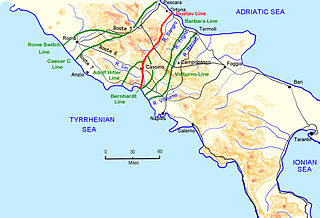
Year 1503 (MDIII) was a common year starting on Sunday of the Julian calendar.

The Garigliano is a river in central Italy.

The Winter Line was a series of German and Italian military fortifications in Italy, constructed during World War II by Organisation Todt and commanded by Albert Kesselring. The series of three lines was designed to defend a western section of Italy, focused around the town of Monte Cassino, through which ran the important Highway 6 which led uninterrupted to Rome. The primary Gustav Line ran across Italy from just north of where the Garigliano River flows into the Tyrrhenian Sea in the west, through the Apennine Mountains to the mouth of the Sangro River on the Adriatic coast in the east. The two subsidiary lines, the Bernhardt Line and the Hitler Line ran much shorter distances from the Tyrrehnian sea to just North East of Cassino where they would merge into the Gustav Line. Relative to the Gustav Line, the Hitler Line stood to the North-West and the Bernhardt Line to the South-East of the primary defenses.

Piero di Lorenzo de' Medici, called Piero the Unfortunate, was the Lord of Florence from 1492 until his exile in 1494.

The Volturno is a river in south-central Italy.

Bartolomeo d'Alviano was an Italian condottiero and captain who distinguished himself in the defence of the Venetian Republic against the Holy Roman Emperor Maximilian.

Pedro Navarro, Count of Oliveto was a Navarrese military engineer and general who participated in the War of the League of Cambrai. At the Battle of Ravenna in 1512 he commanded the Spanish and Papal infantry, but was captured by the French. In the service of Francis I of France, he would supervise the French crossing of the Alps before the Battle of Novara in 1513.

Minturno is a city and comune in the southern Lazio, Italy, situated on the north west bank of the Garigliano, with a suburb on the opposite bank about 18 kilometres (11 mi) from its mouth, at the point where the Via Appia crossed it by the bridge called Pons Tiretius.

Operation Diadem, also referred to as the Fourth Battle of Monte Cassino or, in Canada, the Battle of the Liri Valley, was an offensive operation undertaken by the Allies of World War II in May 1944, as part of the Italian Campaign of World War II. Diadem was supported by air attacks called Operation Strangle. The opposing force was the German 10th Army.
The Battle of Garigliano was fought in 915 between Christian forces and the Saracens. Pope John X personally led the Christian forces into battle. The aim was to destroy the Arab fortress on the Garigliano River, which had threatened central Italy and the outskirts of Rome for nearly 30 years.

The Battle of Garigliano was fought on 29 December 1503 between a Spanish army under Gonzalo Fernández de Córdoba and a French army commanded by Ludovico II, Marquis of Saluzzo.
Nicholas Epigingles, better known by his Latinized surname Picingli, was a Byzantine general active in southern Italy and the Balkans. As strategos of the thema of Longobardia, he led the Byzantine contingent of the Christian league in the Battle of Garigliano in 915. He was killed fighting against the Bulgarians, probably in the Battle of Acheloos on 20 August 917.

Santi Cosma e Damiano is a town and comune in the province of Latina, in the Lazio region of central Italy, whose territory is located partly in the Monti Aurunci area and partly in the Garigliano plain.
Renzo da Ceri, true name Lorenzo dell'Anguillara was as an Italian condottiero. He was a member of the Anguillara family.

Ludovico II del Vasto was marquess of Saluzzo from 1475 until his death. Before his accession as marquis he held the title of Count of Carmagnola.

Suio is a frazione of Castelforte, a municipality in southern Latium, central Italy.

Prospero Colonna (1452–1523), sometimes referred to as Prosper Colonna, was an Italian condottiero in the service of the Papal States the Holy Roman Empire and the Kingdom of Spain during the Italian Wars.
An incomplete list of events which happened in Italy in 1503:
Fabio Orsini was an Italian condottiero and lord of Mentana. He was son of Paolo Orsini, who was murdered in 1503 by Cesare Borgia.
The Battle of Garigliano was fought between the Vandals and the Western Roman Empire in Campania, Italy in 457. After having seized Carthage and made it the capital of their kingdom in 439, the Vandals frequently raided the territories of the Western Roman Empire. In 457, the new emperor Majorian surprised a Vandal-Berber raiding party which was returning with loot from Campania. They were engaged at the mouth of the river Garigliano. Many of the raiders were slaughtered before they could reach their ships or were driven into the sea and drowned. The Vandal king Genseric was avenged a few years later at the Battle of Cape Bon.
This page is based on this
Wikipedia article Text is available under the
CC BY-SA 4.0 license; additional terms may apply.
Images, videos and audio are available under their respective licenses.













